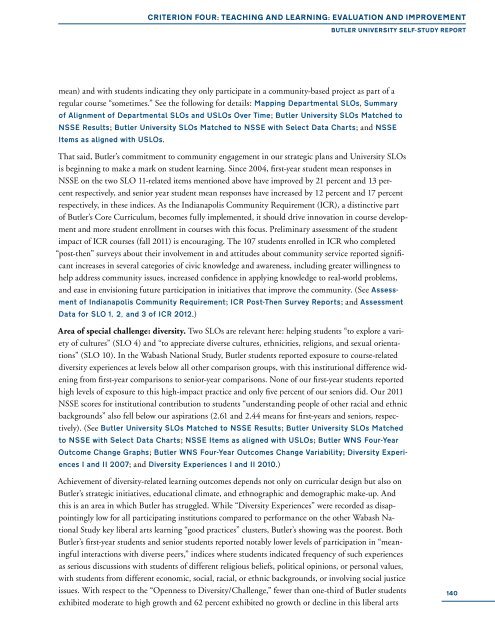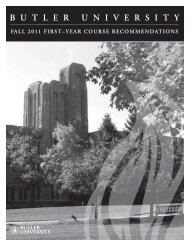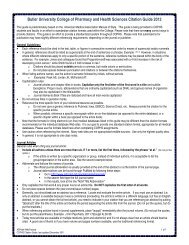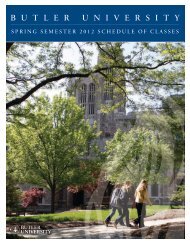Untitled - Show Answer - Butler University
Untitled - Show Answer - Butler University
Untitled - Show Answer - Butler University
Create successful ePaper yourself
Turn your PDF publications into a flip-book with our unique Google optimized e-Paper software.
CRITERION FOUR: TEACHING AND LEARNING: EVALUATION AND IMPROVEMENT<br />
BUTLER UNIVERSITY SELF-STUDY REPORT<br />
mean) and with students indicating they only participate in a community-based project as part of a<br />
regular course “sometimes.” See the following for details: Mapping Departmental SLOs, Summary<br />
of Alignment of Departmental SLOs and USLOs Over Time; <strong>Butler</strong> <strong>University</strong> SLOs Matched to<br />
NSSE Results; <strong>Butler</strong> <strong>University</strong> SLOs Matched to NSSE with Select Data Charts; and NSSE<br />
Items as aligned with USLOs.<br />
That said, <strong>Butler</strong>’s commitment to community engagement in our strategic plans and <strong>University</strong> SLOs<br />
is beginning to make a mark on student learning. Since 2004, first-year student mean responses in<br />
NSSE on the two SLO 11-related items mentioned above have improved by 21 percent and 13 percent<br />
respectively, and senior year student mean responses have increased by 12 percent and 17 percent<br />
respectively, in these indices. As the Indianapolis Community Requirement (ICR), a distinctive part<br />
of <strong>Butler</strong>’s Core Curriculum, becomes fully implemented, it should drive innovation in course development<br />
and more student enrollment in courses with this focus. Preliminary assessment of the student<br />
impact of ICR courses (fall 2011) is encouraging. The 107 students enrolled in ICR who completed<br />
“post-then” surveys about their involvement in and attitudes about community service reported significant<br />
increases in several categories of civic knowledge and awareness, including greater willingness to<br />
help address community issues, increased confidence in applying knowledge to real-world problems,<br />
and ease in envisioning future participation in initiatives that improve the community. (See Assessment<br />
of Indianapolis Community Requirement; ICR Post-Then Survey Reports; and Assessment<br />
Data for SLO 1, 2, and 3 of ICR 2012.)<br />
Area of special challenge: diversity. Two SLOs are relevant here: helping students “to explore a variety<br />
of cultures” (SLO 4) and “to appreciate diverse cultures, ethnicities, religions, and sexual orientations”<br />
(SLO 10). In the Wabash National Study, <strong>Butler</strong> students reported exposure to course-related<br />
diversity experiences at levels below all other comparison groups, with this institutional difference widening<br />
from first-year comparisons to senior-year comparisons. None of our first-year students reported<br />
high levels of exposure to this high-impact practice and only five percent of our seniors did. Our 2011<br />
NSSE scores for institutional contribution to students “understanding people of other racial and ethnic<br />
backgrounds” also fell below our aspirations (2.61 and 2.44 means for first-years and seniors, respectively).<br />
(See <strong>Butler</strong> <strong>University</strong> SLOs Matched to NSSE Results; <strong>Butler</strong> <strong>University</strong> SLOs Matched<br />
to NSSE with Select Data Charts; NSSE Items as aligned with USLOs; <strong>Butler</strong> WNS Four-Year<br />
Outcome Change Graphs; <strong>Butler</strong> WNS Four-Year Outcomes Change Variability; Diversity Experiences<br />
I and II 2007; and Diversity Experiences I and II 2010.)<br />
Achievement of diversity-related learning outcomes depends not only on curricular design but also on<br />
<strong>Butler</strong>’s strategic initiatives, educational climate, and ethnographic and demographic make-up. And<br />
this is an area in which <strong>Butler</strong> has struggled. While “Diversity Experiences” were recorded as disappointingly<br />
low for all participating institutions compared to performance on the other Wabash National<br />
Study key liberal arts learning “good practices” clusters, <strong>Butler</strong>’s showing was the poorest. Both<br />
<strong>Butler</strong>’s first-year students and senior students reported notably lower levels of participation in “meaningful<br />
interactions with diverse peers,” indices where students indicated frequency of such experiences<br />
as serious discussions with students of different religious beliefs, political opinions, or personal values,<br />
with students from different economic, social, racial, or ethnic backgrounds, or involving social justice<br />
issues. With respect to the “Openness to Diversity/Challenge,” fewer than one-third of <strong>Butler</strong> students<br />
exhibited moderate to high growth and 62 percent exhibited no growth or decline in this liberal arts<br />
140







